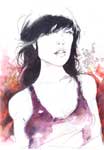When Amy Crump took over as director of the Marshall Public Library in central Missouri two years ago, she decided to build up the library's offerings for young adults by buying the literary world's hot new thing - graphic novels.
"The bulk of our graphic novels are for young adults and they're very popular," Crump said, estimating the library's collection has gone from only a handful to around 75.
Among the new acquisitions was "Blankets" by Craig Thompson and "Fun Home: A Family Tragicomic" by Alison Bechdel, two semi-autobiographical accounts of the respective authors' turbulent childhoods that include ruminations on strict religious upbringing and
homosexuality.
The two novels touched off what Crump said was
the first challenge of library materials in Marshall's 16-year history, as
parents complained that the books, which include pictures of a naked couple,
could be read by children, attracted by the comic book-like drawings.
"My concern does not lie with the content of the novels. Rather my concern is with the
illustrations and their availability to children and the community," said one resident, Louise Mills, during a recent public hearing reported in the Marshall Democrat-News. "Does this community want our public library to continue to use tax dollars to purchase pornography?"
The library board has since removed the two books from circulation while it develops a policy governing how it collects materials in the future, a policy that would determine the novels' eventual fates.
Libraries across the country are increasingly buying graphic novels as they seek to reconnect with younger patrons and respond to popular trends.
The novels, using the pictures and dialogue balloons of comic books to tell sometimes sophisticated stories in book form, are one of the fastest-growing sectors of the publishing industry, selling $250 million last year, according to market research firm ICV2 Publishing.
Milton Griepp, chief executive of ICV2, which tracks pop culture retail, estimated libraries add another 5 percent to 10 percent to retail sales of graphic novels, which totaled only $75 million in 2001.
"The last two or three years' growth has been pretty rapid in libraries, and that's because graphic novels have started to be respected as legitimate literature," Griepp said.
"Maus," a Holocaust memoir by Art Spiegelman, won a Pulitzer Prize in 1992 while Gene Luen Yang's "American Born Chinese" this year became the first graphic novel to be nominated for the National Book Award.
But the books are also gaining more visibility among parents and other community
members who may have never heard of graphic novels but are alarmed to see "cartoon" characters doing and saying very adult things.
"I think there's still a perception in the general public that comics are just for kids, which isn't true and hasn't been true for years," Griepp said.
The Chicago-based American Library Association said it knows of at least 14 graphic novel challenges in U.S. libraries over the past two to three years, which they said reflects the
increasing popularity of the genre with librarians and patrons.
Among the titles were "The Watchmen" by Alan Moore, which was challenged in Florida and Virginia as unsuitable for younger readers; "Akira, Volume 2" by Katsuhiro Otomo,
challenged in Texas for offensive language; and "New X-Men Imperial" by Grant
Morrison, challenged in Maryland for nudity, offensive language and violence.
Even "Maus" and its sequel, "Maus II," were challenged last year in Oregon as anti-ethnic and unsuitable for younger readers. Sometimes the challenges are successful. County officials in Victorville, Calif., removed from their library "Manga: 60 Years of Japanese Comics" because the book included nudity and sexuality.
"Some people find graphical depictions of things more offensive than text," said Carrie Gardner, a spokeswoman for the ALA's Committee for Intellectual Freedom and a professor at Catholic University in Washington, D.C.
Gardner said discussions around graphic novels is similar to what happened when libraries began carrying videotapes and providing access to the Internet.
"Librarians are trained to conduct reference interviews and guide patrons to the resources most appropriate for them," Gardner said. "They should be making those decisions."
---------
First off, I do believe that certain types of graphic novels, as what Benny has been discussing on his blog, are great for education. They can bring unmotivatied students away from watching movies as a short-cut to writing their book reports, into a world rich in language and literature by presenting the novel in a way that's of more interest to them.
But at the same time, I also understand the point of view of the parent's in the library's community - caution in choosing the graphic novels, not only for the library but also for education, does need to be exercised when choosing appropriate material for student's and children in the community.
The graphic novels "Maus" and "Maus II" are acutually great teaching materials for classrooms when discussing WWII, and the Nazi's oppression of the Jew's (In the novel, the Nazi's are appropriately depicted as cats, and Jews as mice). After looking through these particular graphic novels myself, I believe that using the "Maus" novels would be an excellent teaching tool in my future classroom. Again, bringing the unmotivated students into the discussion and learning processes.
Graphic novels are going to become even more popular over the next decade, especially with the Penguin Graphic Novel Series bringing more classic pieces of literature to life in comic-book form. Teachers, and students, can benefit from their way of presenting the novels in a new way - keeping students interested in the material, and even more importantly, having them appeal to a larger student population.


